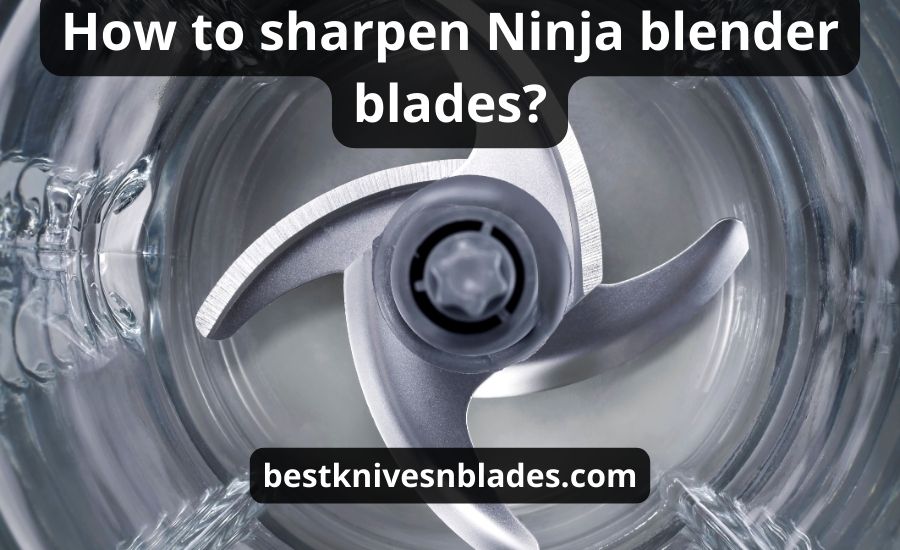Ninja blenders have revolutionized the way we prepare our favorite smoothies, soups, and more. They have truly become a kitchen essential. However, even the most robust blades can lose their edge over time. Dull blades result in uneven blends and longer preparation times. But fret not! In this guide, we’ll walk you through the process of sharpening Ninja blender blades, ensuring that your blender continues to deliver impeccable results.
Blender maintenance often gets overlooked, but it’s a crucial aspect of ensuring your kitchen appliances stay in top shape. Learning how to sharpen Ninja blender blades isn’t just about preserving their cutting power; it’s also about maintaining safety in the kitchen. It’s a handy skill when you’ve just bought a new blender.
Dull blades can make the blending process more challenging and lead to undesirable accidents. So, whether you’re a smoothie enthusiast or an aspiring chef, understanding how to sharpen Ninja blender blades is a valuable skill to obtain.
Throughout this article, we’ll explore the methods for sharpening Ninja blender blades, from using simple tools like a sharpening stone to more innovative approaches like aluminum foil. We’ll also discuss the importance of a flat surface and the process of sharpening blender blades itself.
By the end of this guide, you’ll have the knowledge and skills to bring back the razor-sharp edge to your blades, ensuring your culinary creations remain a cut above the rest.
So, if you’re ready to enhance your blending experience and bring your Ninja blades back to life, let’s dive into the art of sharpening Ninja blender blades.

Blade sharpening: basic technique
Now that you understand the importance of maintaining sharp blender blades, let’s delve into the process and learn how to sharpen Ninja blender blades.
Our guide will walk you through methods and tools you can use to restore your blades to their optimal cutting condition.
Gather your materials
Before you begin to sharpen blender blades, it’s essential to gather the necessary materials and ensure a safe and organized workspace. Here’s what you’ll need:
- Ninja blender: make sure your blender is unplugged and that you’ve removed the blender pitcher with the blades from the motor base.
- Protective gloves: safety is paramount. Wear protective gloves to prevent accidental cuts or nicks while working with a sharp blade.
- Sharpening stone: if you choose to use a sharpening stone, ensure it’s clean and in good condition.
- Flat surface: you’ll need a flat and stable surface to work on, providing a secure platform for the process to sharpen the blades.
- Aluminum foil: this is an alternative method for blade maintenance.

Safety first
Put on your protective gloves to safeguard your hands during the sharpening process. Even if the blades are dull, they can pose a risk, and it’s crucial to take precautions.
Examine the blades
Before you begin, take a close look at the blades to assess their condition. Look for nicks, chips, or any visible damage.
If the blades are severely damaged, you may need to consider replacing them.
Using a sharpening stone
If you opt for this method, use the same stone you employ when sharpening kitchen knives and follow the steps below:
- Place the stone on your flat surface.
- Hold the blade assembly at a consistent angle (usually around 20 degrees) and, with light pressure, run the blade across the sharpening stone in a sweeping motion. Ensure you maintain the same angle for each blade when you sharpen blender blades. And secure that the blade edge is turned in the opposite from you direction.
- Repeat this process for each blade, making several passes until you’ve achieved the desired sharpness.
- After sharpening, thoroughly rinse and dry the blades before reassembling them onto your Ninja blender.

Using aluminum foil
Alternatively, you can use aluminium foil to sharpen blades:
- Fold a sheet of foil a few times to create a thick, layered strip.
- Turn your blender on its side and place the folded foil strip between the blades.
- Run the blender on a medium setting for about 30 seconds. The foil will sharpen the blade edges by abrasive action.
- Afterward, remove the foil and clean the blades.
Reassemble your blender
Once you’re satisfied with the sharpness of your blades, carefully reassemble your Ninja blender, ensuring everything is securely in place.
By following these steps, you can keep Ninja blender blades sharpened, ensuring your blender continues to perform at its best.
How often to sharpen Ninja blender blades?
One common question among Ninja blender users is: “What makes my blades blunt, and how do I know that I need to sharpen blender blades?”
The answer to this largely depends on how often you use your blender and what types of ingredients you blend.
Here are some guidelines to help you determine when it’s time to sharpen your Ninja blender blades, and why they become dull.
It should be noted, however that these guidelines work not only for a Ninja blender but for other blenders as well, like A Hamilton Beach or Blendtec blender.

Frequency of use
If you use your Ninja blender daily or even several times a week, it’s a good idea to inspect and potentially sharpen the blades regularly. Frequent use can lead to quicker dulling of most blender blades, especially if you’re blending tough or fibrous ingredients.
Type of ingredients
The ingredients you blend also play a significant role in blade maintenance. Blending hard items like ice cubes, frozen fruits, or nuts can dull the blades faster than softer ingredients. If your typical blends include these harder elements, you may need to sharpen the blades more often.
Signs of a dull knife
One clear indicator that it’s time to sharpen your Ninja blender blades is a decrease in blending efficiency.
If you notice that your blends are taking longer than usual or that the results are less consistent, you may be due to sharpen the blades.
You might also hear unusual noises during blending, which can be a sign of a dull blade.
Regular inspection
It’s a good practice to periodically inspect your blender’s blades for visible damage, such as nicks or chips. If you see any of these, it’s time for maintenance. Even if there are no visible issues, regular inspection can help you catch problems early.
Personal preference
Some users prefer to sharpen their blender blades on a set schedule, such as once a month, regardless of use. This proactive approach ensures that the blades are always in top condition. It’s a simple preventive measure that can maintain your blender’s performance over the long term.
In general, it’s advisable to sharpen your Ninja blender blades at least every few months, but you may need to do it more frequently if you meet any of the above criteria.
By maintaining sharp blades, you’ll not only enjoy more efficient blending but also extend the lifespan of your blender.

Conclusion
Maintaining sharp blades in your Ninja blender is key to consistently achieving smooth and efficient blends. Blunt blades can lead to uneven results, longer blending times, and even safety concerns in the kitchen.
By adhering to the technique outlined earlier, you can confidently sharpen your Ninja blender blades and ensure they’re always up to the task.
Remember that the frequency of blade maintenance depends on how often you use your blender and the types of ingredients you blend. Regular inspection, looking for signs of dull or damage, is a good practice that can help you catch problems before they affect your blending experience.
Sharpening the blades occasionally will secure excellent performance of your equipment and top quality of your culinary masterpieces.
As a Ninja blender owner, you have the tools and knowledge to keep your blender’s blades in excellent condition, whether you choose to use a sharpening stone, aluminum foil, or other methods.
Your efforts will not only enhance your culinary creations but also extend the lifespan of your beloved appliance.
So, the next time you reach for your Ninja blender to whip up a delicious smoothie or crush ice for your favorite beverage, rest assured that your blades are in peak condition, ready to tackle any blending challenge.
With a well-maintained Ninja blender, you’ll continue to enjoy the convenience and versatility it offers for years to come. Happy blending!
FAQ
Is there a way to sharpen blender blades?
Yes, blender blades can be sharpened using methods like a sharpening stone or aluminum foil.
How often should you replace the Ninja blender blade?
You should consider replacing Ninja blender blades when they are chipped, severely damaged, or no longer sharpen effectively. There’s no fixed timeline; it depends on usage and condition.
How do I sharpen my food processor blades?
Blades in the food processor can be sharpened by using a sharpening stone, but you should check your manufacturer’s guidelines and safety precautions before attempting this. Some blades are not designed for sharpening and should be replaced when dull.
How do you sharpen a blender blade with a Dremel?
To sharpen a blender blade with a Dremel follow the procedure below:
1. Wear safety gear.
2. Remove the blade.
3. Secure it.
4. Use a Dremel with a grinding stone.
5. Gently grind at the same angle.
6. Check sharpness; stop when desired.
7. Clean and reassemble.
Follow safety guidelines and manufacturer instructions.
Can you sharpen the blades on a Ninja blender?
Yes, you can sharpen Ninja blender blades using methods like a sharpening stone or aluminum foil.

